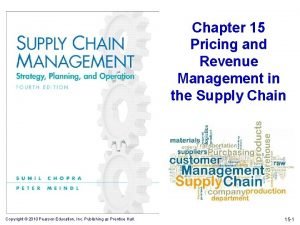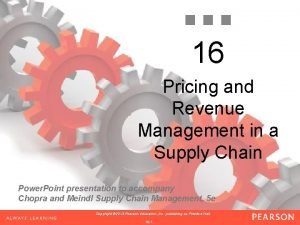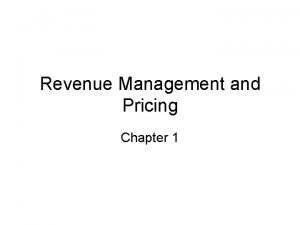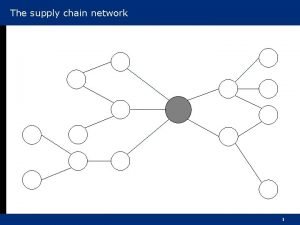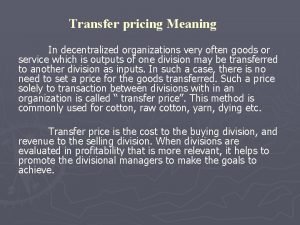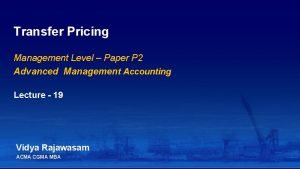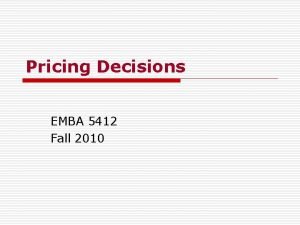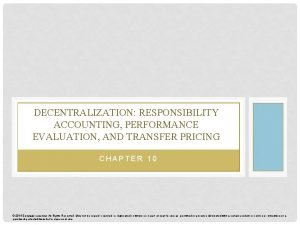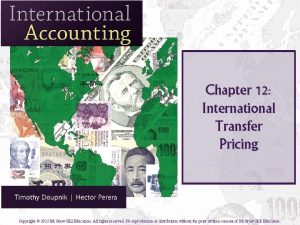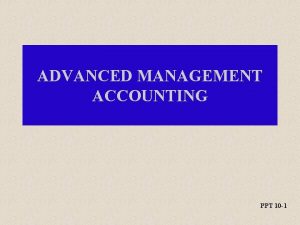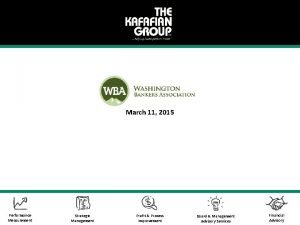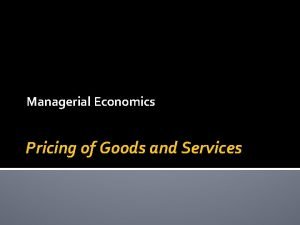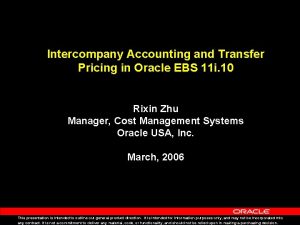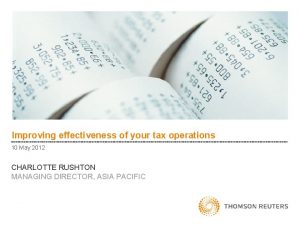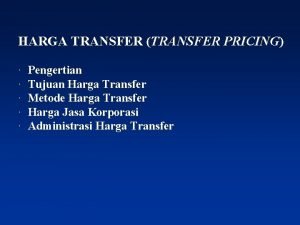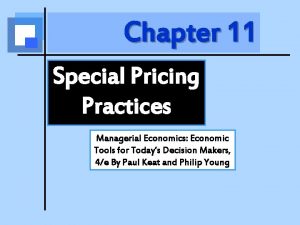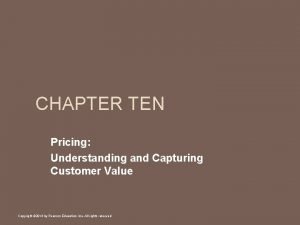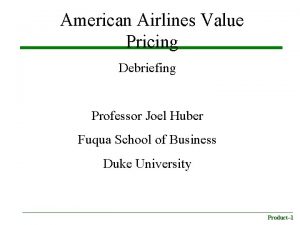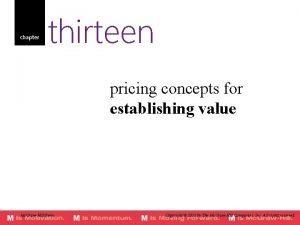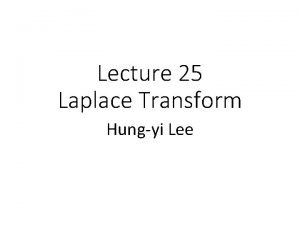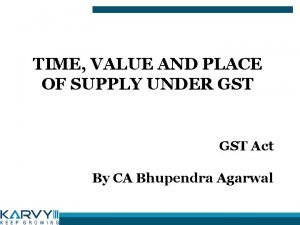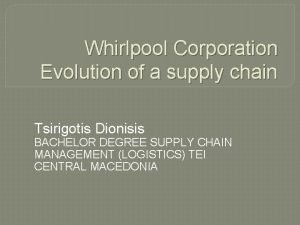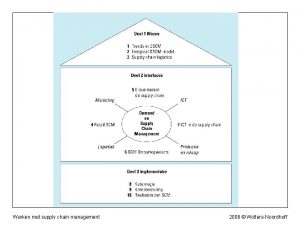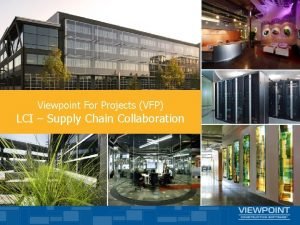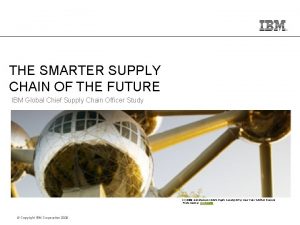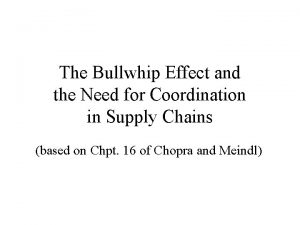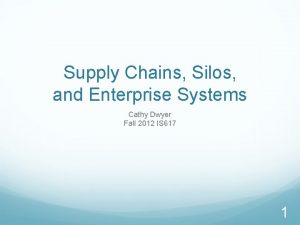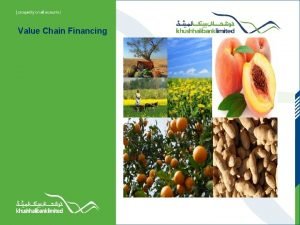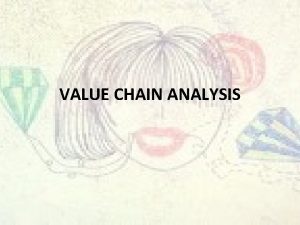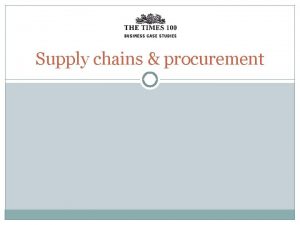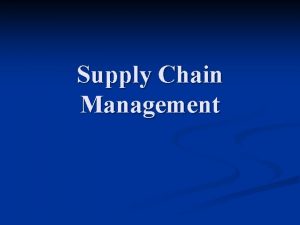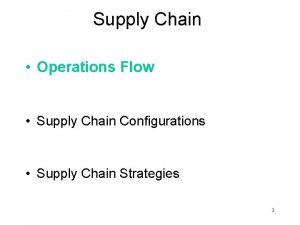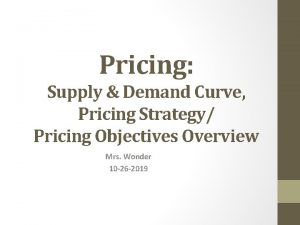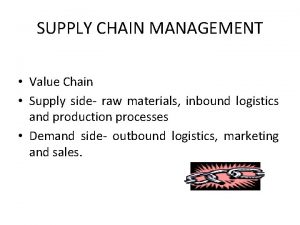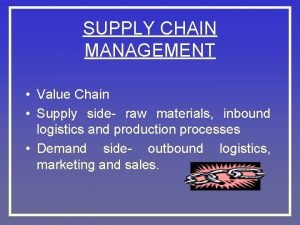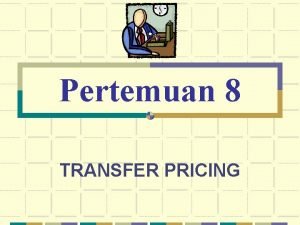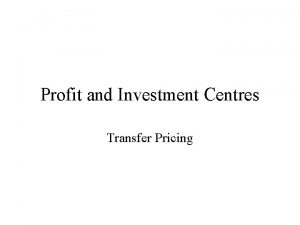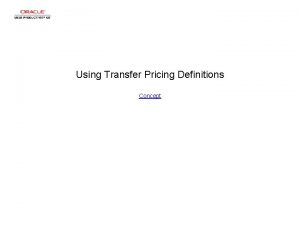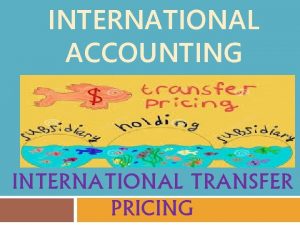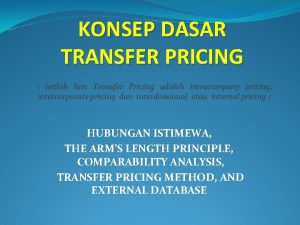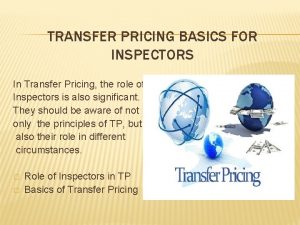Transfer Pricing Supply Chain to Value Chain 08








































- Slides: 40

Transfer Pricing: Supply Chain to Value Chain 08 June 2019

Transfer Pricing - Supply Chain to Value Chain Supply Chain Management is the management of relationships in the network of organizations, from end customers through original suppliers, using key cross-functional business processes to create value for customers and other stakeholders Value Chain A value chain is the full range of activities that firms engage in to bring a product to the market, from conception to final use. Such activities range from design, production, marketing, logistics and distribution to support to the final customer (could be performed by same entity or multiple entities) Transfer pricing (“TP”) – Supply Chain to Value Chain Page ► Shift in arm’s length testing method from ‘transaction’ based to ‘entity based’ ► Shift from testing standalone entities to mapping relative position of group entities involved in process ► Arm’s length price consistent with both tax and business objective 8 June 2019 Transfer Pricing : Supply Chain to Value Chain

Transfer Pricing – Supply Chain to Value Chain Global IP owner IP Finished goods Localdistributors Regional principal Royalties Local distributors Payment X% of system profits Z% of system profits Y% of system profits Pre Base Erosion Profit Shifting (“BEPS”) – Focus of local jurisdictions was more on local transactions – e. g. is distributor appropriately remunerated? Post BEPS, all jurisdictions get full supply chain visibility, giving rise to wider exposure 1 Page Is distributor profitability artificially low because of IP transaction elsewhere? 8 June 2019 2 What value addition does the regional principal do? Transfer Pricing : Supply Chain to Value Chain 3 Does the IP owner have adequate substance?

Globalization of Economies And Decentralization of Functions 1 2 With emergence of multinational enterprise (MNE’s) across different jurisdiction, the company’s competitiveness is in great part influenced by the efficiency of its supply chain and the corresponding value that each function in the supply chain holds. The rationale for spreading supply chain across different jurisdiction may include the following : ► Sourcing of raw material ► Efficient delivery of products / services ► Page Availability of skilled workforce ► Tax efficiency 3 As the MNE’s are realigning their Functions, Assets and Risk (“FAR”) across the supply chain, it leads to different values at different nodes in supply Chain 4 Realigning FAR is leading to a greater need for determining the appropriate transfer price of the transactions in supply chain (basis the value created at each stage) 8 June 2019 Transfer Pricing : Supply Chain to Value Chain

Transfer Pricing – Supply Chain to Value Chain ► Page Organisation for Economic Co-operation and Development (“OECD”) “Action Plan on Base Erosion and Profit Shifting” (2013) highlighted the changes in the global economy and emphasized the importance of Value Chain Analyses: ► Restore the full effects and benefits of international standards, specifically by adapting the rules “to prevent BEPS that results from the interactions among more than two countries and to fully account for global value chains ► Assure that transfer pricing outcomes are in line with value creation” (Action 8, 9 and 10 of BEPS), specifically, by …adopting transfer pricing rules or special measures to: … clarify the application of transfer pricing methods, in particular profit splits, in the context of global value chains (Action 10 of BEPS) ► Re-examine transfer pricing documentation (Action 13) including transparency relating to value-chain analyses ► Post-BEPS, taxpayers are required to support TP policy with a more granular review of functions, risks, and assets ► Such an analysis may help reduce the risk of having transactions re-characterized by tax administrations 8 June 2019 Transfer Pricing : Supply Chain to Value Chain

OECD Guidelines and Action Plans of BEPS issued by OECD Page 1 A mere contractual form of the decision-making process is no longer sufficient to demonstrate the performance of decision-making functions 2 Capability and actual performance of decision making with respect to risk determines the upside and downside of the decision and consequences for enterprise 3 Therefore, in the post-BEPS environment, MNEs need to understand their value chain, including value drivers and related risks and functions 4 Value chain analysis – or at least its components – still permeates the various OECD pronouncements: 8 June 2019 ► Value driver framework underlies the functional analysis of the transfer pricing documentation ► Reference to profit drivers, the supply chain, and value creation in Master file ► Reference to value creation in Chapter VI on intangibles ► Emphasis on value in attribution of profits to PE, and value creation in digital economy Transfer Pricing : Supply Chain to Value Chain

Value Chain – Functions, Risk & Asset analysis 1 2 Page FAR analysis is an important exercise to identify value drivers and value creation by entity Analysis of risk, and therefore appropriateness of return for risk, is very difficult 3 Main elements to ‘controlling a risk’: ► Capability to make a decision to take on, lay off, or decline a risk-bearing opportunity, whether/ how to respond to risks associated with the opportunity together with the actual performance of that decision-making function ► Capability to mitigate risk, together with the actual performance of such risk mitigation ► Having the financial capacity to bear the risk 4 Functions can be outsourced only by the entity exercising control ► Reflects global economic reality ► Centralisation of control functions and ► Widely dispersed routine functions 8 June 2019 Transfer Pricing : Supply Chain to Value Chain

Value Chain – Functions, Risk & Asset analysis 4 5 6 Page Important to determine that which entity has the financial capacity to bear the risk The entity only undertaking financing function without controlling other relevant risk should be entitled to risk free return or risk adjusted return depending on the degree of intensity of financial risk undertaken by it OECD recognises a distinction between ‘controlling’ a risk and ‘managing’ a risk ► Cannot totally divorce risk bearing from risk management ► The party controlling the risk must retain oversight of the outsourced activities in order to merit a risk-based return 8 June 2019 Transfer Pricing : Supply Chain to Value Chain

Full-fledged Manufacturer V. Contract Manufacturer Full Fledged Manufacturer ► A Co Associated Enterprise Country A Purchase of goods B Co • • Country B ► A Co is a full-fledged manufacturer Sell goods to B Co. , which in turns sell goods to customers ► ► Co. A undertakes all the entrepreneurial and operational & strategic activities Co. A assumes all the risks and develops the intangibles related to the production facility Sale of goods Unrelated third parties Page 8 June 2019 C Co • • Value Chain No risk Buys finished goods Contract Manufacturer Country A Delivery of manufactured products Country B Remuneration on cost plus markup D Co Transfer Pricing : Supply Chain to Value Chain Product Specifications Supply Chain Mg Quality Checks Determination of volume level Manufacturing Service

Full-fledged Manufacturer V. Contract Manufacturer Full Fledged Manufacturer Contract Manufacturer ► A Co Associated Enterprise Country A Purchase of goods B Co • • Country B D Co manufacture goods for C Co basis the instructions and under supervision of A Co. ► • • Functions of C co ► C Co determines the volume level for the product and undertakes supply chain risk and capacity utilisation risk ► Provides specifications to D Co. as regard to technical requirements and designs of the product. ► Performs regular quality checks No risk Buys finished goods Unrelated third parties 8 June 2019 C Co Value Chain Sale of goods Page Contract Manufacturer Country A Delivery of manufactured products Country B Remuneration on cost plus markup D Co Transfer Pricing : Supply Chain to Value Chain Product Specifications Supply Chain Mg Quality Checks Determination of volume level Manufacturing Service

Full-fledged Manufacturer V. Contract Manufacturer Full Fledged Manufacturer ► Functions of D co ► A Co Associated Enterprise ► Employs and trains competent manufacturing personnel ► Determines production scheduling based on volume levels determined by C Co. Country A Purchase of goods B Co • • Country B No risk Buys finished goods Transfer Pricing Comments ► D Co. has no ability to manage the risk associated with the recovery of fixed cost ► Significant risks associated with generating a return from the manufacturing activities are controlled by C Co. Sale of goods Unrelated third parties Page 8 June 2019 Builds plants and manufactures products basis the instructions and specifications of C Co. Transfer Pricing : Supply Chain to Value Chain Contract Manufacturer C Co • • Product Specifications Supply Chain Mg Quality Checks Determination of volume level Country A Delivery of manufactured products Country B Remuneration on cost plus markup D Co Manufacturing Service

Full-fledged Manufacturer V. Contract Manufacturer Full Fledged Manufacturer A Co Associated Enterprise ► Consequences of those risks should therefore be allocated to C Co. Contract Manufacturer ► Financial consequences related to the materialisation of that risk including failure to cover fixed costs, should be allocated to C Co ► D Co controls the risk that it fails to competently deliver services Country A Purchase of goods B Co • • ► No risk Buys finished goods Sale of goods Unrelated third parties Page Country B 8 June 2019 ► Therefore, its remuneration should take into account that risk, as well as its funding costs for the acquisition of the manufacturing plant Co. A will be entitled for an entrepreneurial manufacturing return, whereas, Co. D will be entitled for a return for its FAR discussed above, which would be lower than the return of a full fledged manufacturer Transfer Pricing : Supply Chain to Value Chain • • Product Specifications Supply Chain Mg Quality Checks Determination of volume level Country A Delivery of manufactured products Country B Remuneration on cost plus markup D Co Manufacturing Service

Full-fledged Distributor V. Limited Risk Distributor Full Fledged Distributor ► A Co Associated Enterprise • Manufactures goods Country A Sale of goods B Co • • B Co sells goods to the customer as a principal ► Bears risk ► B Co. takes order from unrelated third party and has significant authority to procure goods basis the demand raised by customers B Co. takes the title of goods and bears all the related risks Unrelated third parties 8 June 2019 Associated Enterprise Country A Goods directly sent to C Ltd. Country B Purchase of goods • • D Co No inventory risk Sale on back to back basis Sale of goods Page C Co Value Chain Country B Title to goods Limited Risk Distributor Unrelated third parties Transfer Pricing : Supply Chain to Value Chain

Full-fledged Distributor V. Limited Risk Distributor Full Fledged Distributor Limited Risk Distributor ► A Co Associated Enterprise • Manufactures goods Country A Sale of goods B Co • • Unrelated third parties Page 8 June 2019 Country B Bears risk Title to goods Sale of goods ► Limited Risk Distributor D Co. purchases products from C Co. on a sale/ return basis or customer’s order and in turns sells to customers C Co Goods are transferred directly to customer by the principal C Co. Value Chain Functions of C Co. ► C Co. manufacturers and transfers the goods to the customer ► C Co. undertakes the sales forecasting and budgeting functions ► It also sets price lists and discount rates Transfer Pricing : Supply Chain to Value Chain Associated Enterprise Country A Goods directly sent to C Ltd. Country B Purchase of goods • • D Co No inventory risk Sale on back to back basis Sale of goods Unrelated third parties

Full-fledged Distributor V. Limited Risk Distributor Full Fledged Distributor A Co Associated Enterprise • Manufactures goods Country A Sale of goods B Co ► • • Country B ► ► ► Sale of goods Unrelated third parties Page 8 June 2019 Limited Risk Distributor C Co ► Associated Enterprise C Co. bears the inventory, warranty and credit risks Country A Functions of D Co. Bears risk Title to goods C Co. performs the strategic marketing functions and develops marketing intangibles D Co. buys products from C Co. and sells to the customers D Co. doesn't performs strategic marketing functions and consequently no marketing intangibles are developed. However, it may perform variety of tactical marketing tasks D Co. may be responsible for arranging transportation facility to the customers Transfer Pricing : Supply Chain to Value Chain Goods directly sent to C Ltd. Country B Purchase of goods • • D Co No inventory risk Sale on back to back basis Sale of goods Unrelated third parties

Full-fledged Distributor V. Limited Risk Distributor Full Fledged Distributor A Co Associated Enterprise • Sale of goods • • D Co. buys goods from C Co. on sale/return basis and sells the products ► It takes the title to goods for a limited period of time and bears very limited risk in respect of inventory ► Price and discounts are approved by C Co. , hence D Co. has no credit risk in respect of goods sold to customer Manufactures goods Country A B Co ► Country B Bears risk Title to goods Transfer Pricing Comments ► Sale of goods ► Unrelated third parties Page 8 June 2019 ► Functions of D Co. are close to trader but not akin to trader D Co. doesn’t bear significant risks as compared to the full-fledged distributor. Hence, it is exposed to limited risk. Therefore, return to D Co. should be lower than the full fledged distributor’s return Transfer Pricing : Supply Chain to Value Chain Limited Risk Distributor C Co Associated Enterprise Country A Goods directly sent to C Ltd. Country B Purchase of goods • • D Co No inventory risk Sale on back to back basis Sale of goods Unrelated third parties

Control over risk – Fund Management services Investor Provides Funds for Investment ► Investment Risk ► Determination of Risk preference (portfolio diversification) ► Hiring portfolio Manager Supply Chain ► Investor hires Fund manager and provides funds for investment to Fund Manager ► Fund Manager invests the funds in order to earn returns for investor based on investors risk preference Value contribution analysis Service fee Functions of Investor Fund Manager ► Investment of Funds Investment Fund Page 8 June 2019 Portfolio Investment decisions Operational Risk ► The investor provides funds and bears the gain / loss in value of the investment ► Decides on the level of investments to be made ► Determination of risk preference regarding portfolio diversification ► Hiring Fund Manager ► Decides on extent of authority to be given to fund manager for day to day operations Transfer Pricing : Supply Chain to Value Chain

Control over risk – Fund Management services Investor Provides Funds for Investment ► Investment Risk ► Determination of Risk preference (portfolio diversification) ► Hiring portfolio Manager Service fee Fund Manager ► Investment of Funds Investment Fund Page 8 June 2019 Functions of Fund Manager ► Report back to Investor on regular basis regarding its fund management activities ► Take day to day decision with respect to investment of funds ► Manages his business risk to protect its credibility Transfer pricing Comments Portfolio Investment decisions Operational Risk ► The fund manager’s operational risk, including the possibility of losing a client, is distinct from his client’s investment risk. ► Investor has given fund manager the authority to perform risk mitigation activities; ► but hasn’t transfer the control of the investment risk to the person making these day-to-day decisions ► Investor should bear the financial consequence of failure and success. ► Fund Manager would be remunerated for carrying out fund management services incorporating the risk that it fails to do so competently. Transfer Pricing : Supply Chain to Value Chain

AP 8, 9 & 10 of BEPS: TP outcomes are in line with value creation AP 8: Intangibles ► Definition of “intangibles” ► Introduction of 6 step framework to analyse TP aspects of intangibles ► ► ► Focus on conduct of parties and their capability and functionality to manage risks Assumption of risk without ‘control’ over that risk is likely to be problematic Legal ownership does not guarantee right to the return generated by exploitation of intangible ► Focus on Development, Enhancement, Maintenance, Protection and Exploitation (DEMPE) functions ► Separate consideration regarding an appropriate return to any cash investment ► Introduction of a six step framework to analyse risks for transfer pricing purposes ► Hard-to-Value Intangibles (HTVIs) ► Cost-Contribution Arrangements (CCAs) Page AP 9: Risk and Capital 8 June 2019 Transfer Pricing : Supply Chain to Value Chain AP 10: Other high-risk transactions ► Intra-group services / low value-add services ► Profit Split Method in respect of Global Value Chain ► Recognition of transactions ► Commodity transactions

Value in analysis of intangibles Identify - The relevant intangibles at issue Page 8 June 2019 Manner in which they contribute to the creation of value in the transactions under review Important functions performed and specific risks assumed in connection with the Development, Enhancement, Maintenance, Protection and Exploitation (“DEMPE”) of the intangibles; and Manner in which they interact with other intangible assets, tangible assets and business operations to create value Transfer Pricing : Supply Chain to Value Chain Items not treated as intangibles can also contribute to the creation of value in the context of the MNE’s global business and the same should be taken into account in the determination of ALP Legal owner of an intangible may receive the proceeds from exploitation of the intangible Other members of the MNE group performing functions, using assets, or assuming risks for contributing to the value of the IP must be compensated for their contributions under the ALP

Value in analysis of intangibles For determining arm’s length compensation, it is necessary to determine, which member(s) perform following functions – ► Exercise control over DEMPE functions, ► Funding and other assets, and ► Assume the various risks associated with the intangible MNE group member(s) making the more significant contributions in a particular case should receive relatively greater remuneration ► For example, a company that merely funds research and development should have a lower anticipated return than if it both funds and controls research and development ► Other things being equal, a still higher anticipated return should be provided if the entity funds, controls, and physically performs the research and development In cases involving the use or transfer of intangibles, the manner in which intangibles are used by the MNE to add or create value across the entire supply chain needs to be analysed Page 8 June 2019 Transfer Pricing : Supply Chain to Value Chain

What constitutes DEMPE functions? Questions for evaluating existence of DEMPE functions: Who designs and controls research and marketing programmes? Who manages and control of budgets? Who takes decisions regarding intangible development programmes? Who takes important decisions regarding defence and protection of intangibles? Who determines the level of staffing for research and marketing activities? Who makes actual decisions to pursue or terminate research or marketing programs? ? Who actually supervises research projects and exercises quality control over functions performed? Any group companies performing DEMPE functions on behalf of the legal owner must be remunerated accordingly The new OECD guidance focuses on ‘substance’ for conducting TP analysis of intangibles Page 8 June 2019 Transfer Pricing : Supply Chain to Value Chain

Value in analysis of Intangibles - Strong Focus on DEMPE functions Development of intangible asset Enhancing value of intangible asset Maintenance of intangible asset Protection of intangible asset against infringement Exploitation ► Accurate delineation of the actual transaction is fundamental: contracts needs to be reviewed against conduct ► There is no automatic return on account of mere legal ownership of intangible ► Provision of funding alone: no more than a risk-free financial return ► Requirement to directly perform or to control the performance of DEMPE functions and related risks ► Return retained by an entity in group depends on the contributions it makes through DEMPE functions to the anticipated value of intangible relative to contributions made by other group members ► Differences between anticipated and actual profits are allocated depending on assumption of risk/ functions that warrant a profit share Page 8 June 2019 Transfer Pricing : Supply Chain to Value Chain

Value in analysis of Intangibles - Strong Focus on DEMPE functions Pure Funding Legal ownership Routine return for IP ownership (a) Page 8 June 2019 Risk adjusted or Risk free rate of return (b) – Refer Note below) Legal ownership + Funding obligations + DEMPE functions Total system returns Residual returns (a) + (b) ► Funder that takes certain financial risks and exercises control entitled to Risk Adjusted Rate of Return ► Funder that does not control financial risk should be entitled to no more than a risk-free financial return Transfer Pricing : Supply Chain to Value Chain

DEMPE - Research & Development services Supply Chain Manufacture Products F Co ► F Co, parent company of I Co & S Co, is engaged in manufacturing activities ► I Co and S Co are research & development (“R&D”) centres of MNE group Funding Country F Country I Country S Payment of Inte rest Value contribution analysis ► Payment Provision of Contract R&D services ► Provision of R&D services Payment of Interest I Co Page 8 June 2019 S Co Supervision for R&D function Functions of F Co ► Manufacture and sale of products ► Legal owner of the intangibles developed by I and S Co. ► Bears the financial risk associated with failure of R&D projects Functions of I Co ► Develop its own research prog, budgets, makes determinations as to when R&D projects are to be terminated or modified and hire its own R&D staff. ► Exercise control over the research functions carried out by Co. I and Co. S ► Monitors & take all relevant R&D related decisions of Co. S as well. Transfer Pricing : Supply Chain to Value Chain

DEMPE - Research & Development services Functions of S Co Manufacture Products ► F Co Funding Design and development of research programme under the supervision and control of I Co Transfer pricing Comments Country F Country I Country S Payment of Inte rest ► The transfer pricing analysis begins by identifying the commercial or financial relations between the parties and the conditions and economically relevant circumstances attaching to those relations in order that the controlled transaction is accurately delineated. ► Co. I is entitled to returns derived from the exploitation of the intangibles developed through the R&D efforts of Company I and Company S, both ► Company S is entitled to compensation for its functions performed, assets used, and risks assumed in relation to the R&D activities carried out by Co. S ► In determining the amount of compensation due to Co. S, the relative skill and efficiency of the R&D personnel at Co. S, the nature of the research being undertaken, and other factors contributing to value should be considered as comparability factors Payment Provision of Contract R&D services Provision of R&D services Payment of Interest I Co Page 8 June 2019 S Co Supervision for R&D function Transfer Pricing : Supply Chain to Value Chain

DEMPE - Research & Development services Manufacture Products ► F Co. functions as a manufacturer and performs no activities in relation to the DEMPE of the intangibles and does not control risks in relation to the acquisition of the intangibles or to their further development ► Instead, all development activities and risk management functions relating to the intangibles are performed by I Co and S Co, with I Co. controlling the risk. ► Although Company F contractually assumes the financial risk and has the financial capacity to assume that risk, it does not exercise control over that risk ► As a result, in addition to its manufacturing reward, Co. F is entitled to no more than a risk-free return for its funding activities F Co Funding Country F Country I Country S Payment of Inte rest Payment Provision of Contract R&D services Provision of R&D services Payment of Interest I Co Page 8 June 2019 S Co Supervision for R&D function Transfer Pricing : Supply Chain to Value Chain

Value in analysis of intangibles Marketing service providers ► While determining the appropriate compensation to the marketer / distributor the following aspects shall be considered ► Where a distributor acts merely as an agent, being reimbursed for its promotional expenditures and being directed and controlled in its activities by the owner of the trademarks and other marketing intangibles ► Further, it does not assume the risks associated with the further development of the trademark and other marketing intangibles, and would therefore not be entitled to additional remuneration and should be compensated only for its agency functions ► Factors such as risks borne, specific market characteristics, location, business strategies, and MNE group synergies among others, may also result contribute to value creation ► The marketer / distributor shall not only be entitled for distribution services it undertakes but also for the activities it undertakes for enhancing the value of trademarks and other marketing intangibles by virtue of functions performed, assets used and risk assumed by it while performing these services ► The obligations and rights implied by the legal registrations and agreements between the parties ► The intangible value anticipated to be created through the marketer/distributor’s activities Page 8 June 2019 Transfer Pricing : Supply Chain to Value Chain

Value in analysis of intangibles Marketing service providers Manufacture Watches F Co Provision of MSS Remuneration Purchases on Cost plus markup Country F Country I I Co Sales Undertakes marketing function under supervision and in consultation with F Co Customer Page 8 June 2019 Supply Chain ► F Co. , parent company of I Co. , manufactures watches (with R trademark) in Country F ► I Co. has been set up in Country I to undertake distribution activities Value Chain ► Functions of F Co ► Registered owner of trademark and trade name ► Marketed the said trademark across the globe (except Country I) ► Granted exclusive right to market and distribute the watches bearing R trademark to I Co. (royalty free agreement) ► Develops overall marketing plan and approves marketing budgets; ► Takes final decision regarding advertisement design, product positioning and core advertisement Transfer Pricing : Supply Chain to Value Chain

Value in analysis of intangibles Marketing service providers Manufacture Watches F Co Provision of MSS Remuneration Purchases on Cost plus markup Country F Country I I Co Sales Undertakes marketing function under supervision and in consultation with F Co Function of I Co. ► Undertakes marketing and distributing activities for watches bearing R trademark in Country I ► Acts as marketing agent to assist in developing market for watches. ► Develops marketing strategy in consultation with F Co. ► Consults with F Co for local market issues related to advertising, assistance in executing marketing strategy under F Co direction Transfer pricing Comments ► I Co. should be reimbursed by F Co. for the marketing expenses it incurs, and should be paid an arm’s length mark-up on those expenses ► F Co. under these circumstances is entitled to retain any income derived from exploiting the R trademark and trade name in the Country I that exceeds the arm’s length compensation to Company S for its marketing functions. Customer Page 8 June 2019 Transfer Pricing : Supply Chain to Value Chain

Value in analysis of Intangibles Six Steps Process for analysing Intangibles 1 Identify legal owner 2 Identify contributors 3 Detailed functional analysis 4 Identify controlled transactions relating to development, enhancement, maintenance, protection and exploitation 5 ‘Where possible’ determine arm’s length prices for contributions 6 ‘In exceptional circumstances’ re-characterise transactions to achieve arm’s length conditions Page 8 June 2019 Transfer Pricing : Supply Chain to Value Chain OECD Action 8 report favours profit split methods (“PSM”) over comparable based methods

Transfer Pricing – Supply Chain to Value Chain ► Inappropriate returns should not accrue to an entity solely because it has contractually assumed risks or has provided capital ► Alignment of returns with value creation is required ► Action plan (“AP”) - 10 of BEPS issued by OECD proposes to develop rules to prevent BEPS involving transactions which would not (or would only very rarely) occur between third parties This will involve: Page ► Adopting rules to clarify the circumstances in which transactions can be re-characterized; ► Clarifying the application of TP methods (profit splits in particular) in the global value chain context; and ► Providing protection against common types of base-eroding payments such as management fees and head office expenses. 8 June 2019 Transfer Pricing : Supply Chain to Value Chain

OECD Analytical Framework for Risk Analysis 1 Identify economically significant risks with specificity 2 Determine contractual risk allocation 3 Determine how the associated enterprises (“AE”) operate in relation to assumption and management of risks, in particular control functions and financial capacity to assume risk 4 Interpret the outcome of step 1 -3 and determine whether the contractual assumption of risk is consistent with actual conduct 5 Where the party assuming risk does not control the risk or does not have the financial capacity to assume the risk, apply specific guidance on allocating risk 6 The transaction as accurately delineated should be priced, appropriately compensating risk management functions Page 8 June 2019 Transfer Pricing : Supply Chain to Value Chain the

Value Chain analysis through Profit-Split method (PSM) 1 Objective of the AP of BEPS is to ensure that TP outcomes are in line with economic value creation 2 Accurately delineate the actual transaction and pricing it in accordance with the most appropriate method (“MAM”) 3 Transactional profit splits acts as a useful method that advocates aligning profits with value creation, particularly in situations where the features of the transaction makes the application of other transfer pricing methodologies problematic 4 PSM helps in aligning contributions made by the AEs to the relative values of their respective functions, assets and risks 5 Contribution Analysis - The relevant profits from controlled transactions are divided between the associated enterprises based upon the relative value of the contributions made by each of the associated enterprises 6 Analysis is supplemented where possible by external market data that indicate how independent enterprises would have divided profits in similar circumstances Page 8 June 2019 Transfer Pricing : Supply Chain to Value Chain

Value Chain analysis through Profit-Split method (PSM) Determination of profit splitting factors: The functional analysis and an analysis of the context in which the transactions take place (e. g. the industry and environment) are essential to the process of determining the relevant factors to use in splitting profits, including determining the weighting of applicable profit splitting factors, in cases where more than one factor is used The determination of appropriate profit splitting factor(s) should reflect the key contributions to value in relation to the transaction Profit splitting factors may include the following: - Page ► Figure (based on similar split achieved between comparable transactions) or Variable which could be calculated on the basis of a single profit splitting factor or a weighting of multiple factors ► Assets, Capital or Cost ► Other profit splitting factors include incremental sales, or employee compensation (relating to the individuals involved in the key functions that generate value to the transaction). Headcount or time spent by a certain group of similarly skilled employees with similar responsibilities could be used if there is a strong and relatively consistent correlation between this and the creation of value represented by the relevant profits. 8 June 2019 Transfer Pricing : Supply Chain to Value Chain

Value Chain - Profit-Split method (PSM) A Co Design & Manufacturers product, sells to B for further development Country A Sale to B B Co Country B Innovates further and sells to C, the distributor at ALP Supply Chain ► Co A is a manufacturer and undertakes R&D activities ► Co B acts as a distributor and also undertakes R&D activities (innovation) ► C Ltd also acts as a distributor and sells the product to customers Value Chain ► Unique and valuable contribution by A Co other than routine manufacturing ► B Co also undertakes R&D activities to enhance the value of product ► C Ltd undertakes full fledged distributor function Transfer pricing Comments Develops further and sell to C Country C C Ltd Page 8 June 2019 Procures at ALP and sells the product in market ► If the price of selling by B Co. to C Ltd has been accepted at ALP, the return from the said transaction can be reliably ascertained. ► Post reducing the return for manufacturing function by A & B Co. , the residual profit may be split on the basis of value created in the supply chain. Same can be computed using the ratio of R&D expenses or other appropriate parameters Transfer Pricing : Supply Chain to Value Chain

Value Chain - Profit-Split method (PSM) A Co Design & Manufacturers product, sells to B for further development Country A Sale to B B Co Country B ► A Co. is the owner of ‘X’ brand ► B Ltd. is the owner of the hotel in Country B, and has entered into a contract with A Co. to operate the hotel under the brand name owned by A Co. ► A Co. will also manage the operation, maintenance, reservation system of hotel ► For the above-mentioned services, A Co. will be compensated on the percentage of revenue. By virtue of the hotel being at the disposal of A Co. , it constitutes fixed place PE in Country B, assuming the conditions specified in DTAA are satisfied Innovates further and sells to C, the distributor at ALP Transfer pricing Comments Develops further and sell to C Country C C Ltd Page 8 June 2019 Procures at ALP and sells the product in market ► For determining the income to be attributed to PE, ‘contribution analysis’ can be considered ► Identify all functions undertaken by Co. A in the provision of such services ► Identify all risks assumed by Co. A in the provision of such services ► Identify all assets (intangible and tangible) used by Co. A in provision of such services Transfer Pricing : Supply Chain to Value Chain

Value Chain - Profit-Split method (PSM) A Co IP owner and engaged in operation of hotels Country A Country B Agreemen ts with respect to operation, CRS, brand use Independent third party owning the hotel enters into agreement with A Co. Basis the functional analysis, contribution of each function, risk and assets can be determined and accordingly, weight can be given ► Further, it is to be determined which all functions (and risks) in relation to the services have been carried out or assumed by fixed place AE and to which extent ► Similarly, for the assets also, it is to be determined, out of the total assets used, how much of the assets based in Country B have been used Basis the said percentage or relative contribution, the revenue/ profit generated by A Co. from this arrangement can be attributed to PE in Country B Fixed Place PE B Ltd ► Provision of certain services undertaken through hotel considered as PE of A Co. S. no. Activities undertaken A. Functions/ Risk analysis 1 Sales & Marketing 2 Centralised services under CSA 3 Hotel Management services B. Asset analysis 1 Intangible assets 2 Tangible assets A+B Total Page 8 June 2019 Transfer Pricing : Supply Chain to Value Chain Weight 66. 67 22. 22 22. 23 33. 33 16. 67 100 Weighted average PE of A Co. 66. 67% 0. 00% Contribution of Weighted average n of A Co. PE of A Co. 100% 0% 22. 22 0% 100% 0% 22. 23 0% 25% 8. 33% 100% 0% 16. 67 0% 50% 8. 33 8% 91. 67% 8. 33%

Points for Consideration AP 3, 13 Parent Co AP 810, 13 Transfer of IP ► TP documentation and Cb. CR could reveal key data with respect to an MNC’s IP activities and highlight low substance entities with material low tax income Cost plus mark up AE in UK ► Focus on transactions such as royalty payments, R&D activities, sales activities, manufacturing activities, etc. ► DEMPE functions need to be assessed to determine intangible related return ► Remuneration of the IP owner should be in line with its FAR (e. g. , funders to receive funding return; legal owners to receive return for legal administrative functions) ► Treaty shopping to achieve reduced withholding or withholding tax exemptions ► Preferential tax regimes for IP income would need to comply with the “nexus approach” License fee/ Royalty Licensing of IP Singapore Co AP 6 Greater scrutiny and focus on substance Management Service Lux Co AP 5 ► Contract R&D Cost plus mark up Sub-Licensing of IP AP 810, 13 6 License fee/ Royalty I Co 1 I Co 2 AP 810, 13 Page 8 June 2019 Transfer Pricing : Supply Chain to Value Chain

Thank You Thank you
 Value chain and supply chain difference
Value chain and supply chain difference Role of pricing and revenue management in a supply chain
Role of pricing and revenue management in a supply chain Role of pricing and revenue management in a supply chain
Role of pricing and revenue management in a supply chain Revenue management and pricing
Revenue management and pricing Matching supply and demand in supply chain
Matching supply and demand in supply chain Value advantage in supply chain management
Value advantage in supply chain management Value creation value delivery value capture
Value creation value delivery value capture Transfer price
Transfer price Transfer pricing example
Transfer pricing example Transfer pricing examples
Transfer pricing examples Types of responsibility accounting
Types of responsibility accounting Transfer pricing example
Transfer pricing example Importance of transfer pricing
Importance of transfer pricing Decentralization and transfer pricing ppt
Decentralization and transfer pricing ppt Fund transfer pricing
Fund transfer pricing Pricing methods in managerial economics
Pricing methods in managerial economics Multi-state transfer pricing analysis
Multi-state transfer pricing analysis Oracle transfer pricing
Oracle transfer pricing Oecd business restructuring
Oecd business restructuring Transfer pricing
Transfer pricing Global transfer pricing survey
Global transfer pricing survey Wu transfer pricing center
Wu transfer pricing center Pengertian transfer pricing
Pengertian transfer pricing Pricing practices in managerial economics
Pricing practices in managerial economics Eltonian pyramid
Eltonian pyramid Pricing understanding and capturing customer value
Pricing understanding and capturing customer value American airlines value pricing
American airlines value pricing Pricing concepts for establishing value
Pricing concepts for establishing value Is a disturbance that transfers energy from place to place
Is a disturbance that transfers energy from place to place Chapter 5 section 1 supply and the law of supply
Chapter 5 section 1 supply and the law of supply Elastisidad ng suplay
Elastisidad ng suplay Initial value theorem
Initial value theorem Time and value of supply under gst
Time and value of supply under gst Whirlpool supply chain
Whirlpool supply chain Werken met supply chain management noordhoff
Werken met supply chain management noordhoff Supply chain lci
Supply chain lci Contemporary issues in supply chain management ppt
Contemporary issues in supply chain management ppt Ibm supply chain risk management
Ibm supply chain risk management Pipeline in supply chain
Pipeline in supply chain Behavioral obstacles in supply chain
Behavioral obstacles in supply chain Supply chain silos
Supply chain silos

